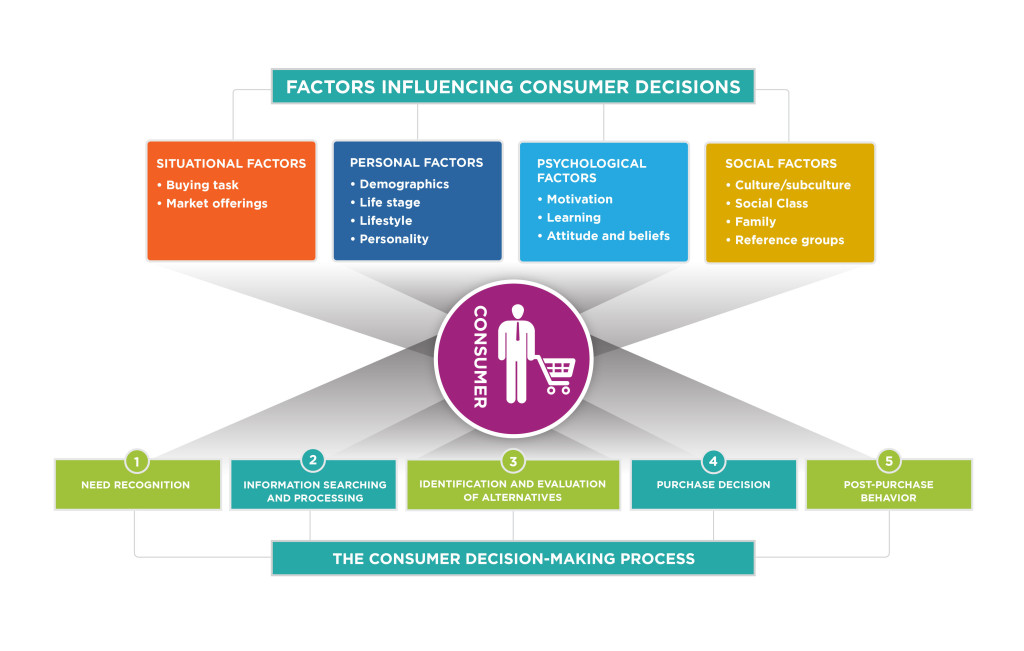2.1.4: Factors Influencing Consumer Decisions
- Page ID
- 83958
The consumer decision process helps you understand the steps people go through when they are deciding whether and what to buy. Many different factors can influence the outcomes of purchasing decisions.
Some of these factors are specific to the buying situation: what exactly you are buying and for what occasion. Other factors are specific to each person: an individual’s background, preferences, personality, motivations, and economic status. Because no two people are exactly alike, it is difficult to predict how the tangled web of influencing factors will ultimately shape a final purchasing decision.
For marketers, an understanding of these factors provides a more complete view into the mind of the customer. As you learn more about what influences decisions for your particular target segment, product category, brand, and competitive set, you can use these influencing factors to your advantage. What you say to customers, the words you use, the people who say them, the images they evoke—all of these things can link back to that web of influencing factors at work in a purchaser’s mind. Great marketing uses those connections powerfully and effectively to win the minds and hearts of customers.
What, Exactly, Influences a Purchasing Decision?
While the decision-making process itself appears quite standardized, no two people make a decision in exactly the same way. People have many beliefs and behavioral tendencies—some controllable, some beyond our control. How all these factors interact with each other ensures that each of us is unique in our consumer actions and choices.
Although it isn’t feasible for marketers to react to the complex, individual profiles of every single consumer, it is possible to identify factors that tend to influence most consumers in predictable ways.
The factors that influence the consumer problem-solving process are many and complex. For example, as groups, men and women express very different needs and behaviors regarding personal-care products. Families with young children tend to make different dining-out choices than single and married people with no children. A consumer with a lot of prior purchasing experience in a product category might approach the decision differently from someone with no experience. As marketers gain a better understanding of these influencing factors, they can draw more accurate conclusions about consumer behavior.
We can group these influencing factors into four sets, illustrated in the figure below:
- Situational Factors pertain to the consumer’s level of involvement in a buying task and the market offerings that are available
- Personal Factors are individual characteristics and traits such as age, life stage, economic situation, and personality
- Psychological Factors relate to the consumer’s motivation, learning, socialization, attitudes, and beliefs
- Social Factors pertain to the influence of culture, social class, family, and reference groups

Situational Factors
Buying Task
The buying task refers to the consumer’s approach to solving a particular problem and how much effort it requires. The level of consumer involvement is an important part of the buying task: whether the buyer faces a high-involvement decision with lots of associated risk and ego involved, versus a low-involvement decision with little risk or ego on the line.
Product or brand familiarity is another, related dimension of the buying task. When a consumer has purchased a similar product many times in the past, the decision making is likely to be simple, regardless of whether it is a high- or low-involvement decision. Suppose a consumer initially bought a product after much care and involvement, was satisfied, and continued to buy the product. For the buyer, this is still a high-involvement decision, but now it’s simpler to make. The customer’s careful consideration of a product and the subsequent satisfaction have produced brand loyalty, which resulted from involvement in the product decision.
Once a customer is brand loyal, a simple decision-making process is all that is required for subsequent purchases. The consumer now buys the product through habit, which means making a decision without additional information or needing to evaluate alternatives. Selling to and satisfying brand-loyal customers can be a great position for marketers, although it’s important not to rest on one’s laurels and take them for granted. New competitors are always looking for ways to break existing brand-loyal habits and lure the consumer into an enticing new product experience.
Market Offerings
The available market offerings are another relevant set of situational influences on consumer problem solving. The more extensive the product and brand choices available to the consumer, the more complex the purchase decision process is likely to be. And the more limited the market offerings are, the simpler the purchase decision process is likely to be.

For example, if you already have purchased or are considering purchasing a smartphone, you know that there are multiple brands to choose from—Samsung Galaxy, Apple iPhone, Sony, LG, HTC One, and Nokia, to name several. Each manufacturer sells several models that differ in various features–design, screen size, memory, speed, camera quality, and so on. What criteria are important to you? Is purchasing a smartphone an easy decision? If a consumer has a need that can be met by only one product or one outlet in the relevant market, the decision is relatively simple: Either buy the product or let the need go unmet.
This is not ideal from the customer’s point of view, but it does happen. For example, suppose you are a student on a campus in a small town many miles from another marketplace. Your campus and town have only one bookstore. You need a textbook for class tomorrow; only one particular book will do, and only that bookstore carries it. Amazon and other online retailers have the book at a lower price, but they can’t get the book to you overnight, so you’re stuck. In this case the limitation on alternative market offerings has a clear influence on your purchase behavior.
As you saw in the smartphone example, when the extent of market offerings increases, the complexity of the problem-solving process and the consumers’ need for information also increase. A wider selection of market offerings is better from the customers’ perspective, because it allows them to tailor their purchases to their specific needs. However, lots of choices may also confuse and frustrate the consumer, such that less-than-optimal choices are made.
Marketers can find opportunities in either scenario—a crowded competitive set and a complex decision for the consumer, or a narrow competitive set with limited choices and a simpler decision for the consumer. In a crowded field, the marketer’s challenge is to make compelling offerings and useful information prominent in the consumer’s processes for gathering information and evaluating alternatives. In a narrow field with limited choices, effective marketing can help the consumer feel good about the choice they had to make. A good experience with the product during and after purchase is a recipe for brand loyalty.
- Holland, Stephanie. “Marketing to Women Quick Facts.” She-Conomy, 15 Sept. 2016, http://she-conomy.com/report/marketing-to-women-quick-facts. ↵
- https://journalofinternationalmanagement.wordpress.com/2011/05/16/walmarts-downfall-in-germany-a-case-study/ ↵
- Revision and Adaptation. Authored by: Lumen Learning. License: CC BY: Attribution
- Introduction to Factors Influencing Consumer Decisions. Provided by: Lumen Learning. License: CC BY: Attribution
- Putting Consumer Attitudes and Beliefs to the Test. Provided by: Lumen Learning. License: CC BY: Attribution
- Chapter 4: Understanding Buyer Behavior, from Introducing Marketing. Authored by: John Burnett. Provided by: Global Text. Located at: http://solr.bccampus.ca:8001/bcc/file/ddbe3343-9796-4801-a0cb-7af7b02e3191/1/Core%20Concepts%20of%20Marketing.pdf. License: CC BY: Attribution
- GALAXY S (I9000). Authored by: Cheon Fong Liew. Located at: https://www.flickr.com/photos/liewcf/4764970338/. License: CC BY-SA: Attribution-ShareAlike

